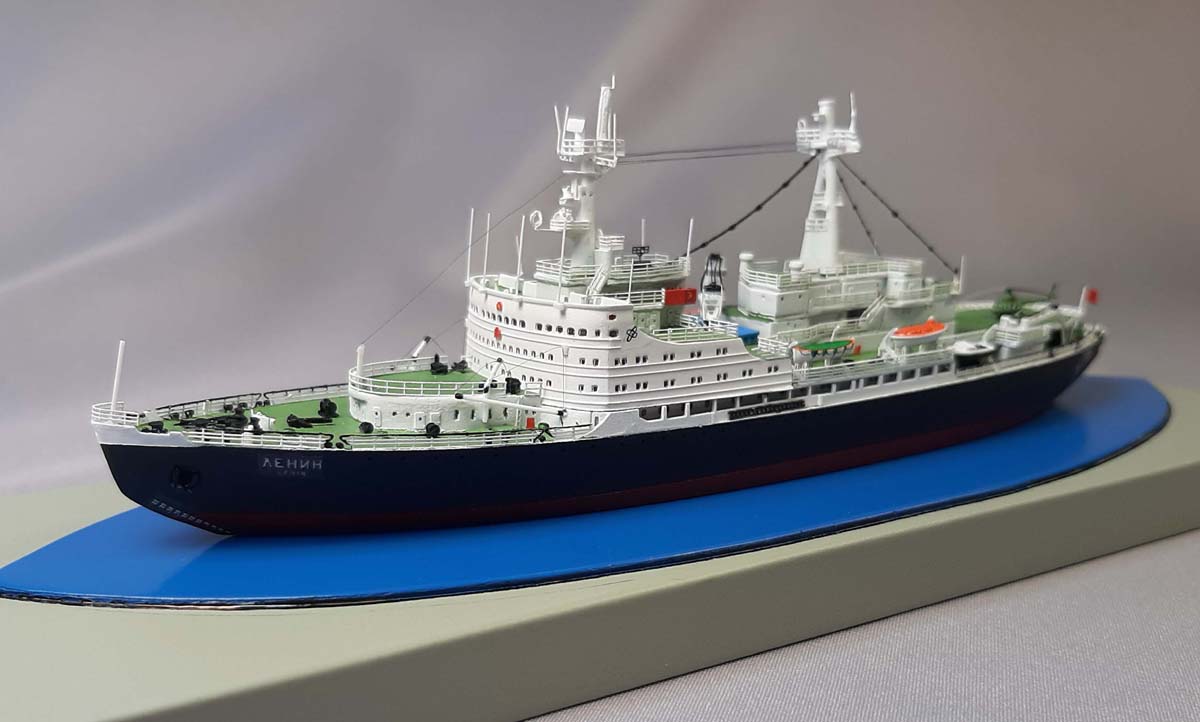
1/700 Icebreaker Lenin (Combrig)
|
by Joe Thompson |

1/700 Icebreaker Lenin (Combrig)
My Combriq 1/700 resin model of the historic Russian nuclear icebreaker “Lenin”. I was fortunate enough to visit the “Lenin” while on a cruise port stop in Murmansk in July 2019. (Another bucket list item crossed off!)The Lenin, a Soviet nuclear-powered icebreaker launched in 1957, was both the world's first nuclear-powered surface ship and she is also the first nuclear-powered civilian vessel. Lenin entered operation in 1959 and worked clearing sea routes for cargo ships along Russia's northern coast. From 1960 to 1965 the ship covered over 85,000 miles during the Arctic navigation season, of which almost 65,000 were through ice. She was officially decommissioned in 1989 and subsequently converted to a museum ship and is now permanently moored in Murmansk.
Lenin was initially powered by three OK-150 reactors. In its late-1960s configuration, at full capacity the ship used 5 to 6 pounds of uranium-235 every 100 days. In the configuration employed from 1970, two OK-900 reactors provided steam for 4 steam turbines that were in turn connected to generators, which powered three sets of electric motors to drive the ship's three propellers.
Nuclear accidents
In February 1965, there was a loss-of-coolant accident. After being shut down for refueling, the coolant was removed from the number two reactor before the spent fuel had been removed. As a result, some of the fuel elements melted and deformed inside the reactor. This was discovered when the spent elements were being unloaded for storage and disposal. 124 fuel assemblies (about 60% of the total) were stuck in the reactor core. It was decided to remove the fuel, control grid, and control rods as a unit for disposal; they were placed in a special cask, solidified, stored for two years, and dumped in Tsivolki Bay (near the Novaya Zemlya archipelago) in 1967.
The second accident was a cooling system leak which occurred in 1967, shortly after refueling. Finding the leak required breaking through the concrete and metal biological shield with sledgehammers. Once the leak was found, it became apparent that the sledgehammer damage could not be repaired; subsequently, all three reactors were removed by blowing them through the bottom of the ship (you read that correctly!) with shaped charges while the ship was positioned above a burial site off Novaya Zemlya. She was then towed back to Murmansk where a multiyear refit was performed and two OK-900 reactors were installed in the ship. This was completed in early 1970. [Note: The water depth at the burial site is only 40-50 meters: 130-165 ft. From 1946 through 1993, thirteen countries (fourteen, if the USSR and Russia are considered separately) used ocean disposal or ocean dumping as a method to dispose of nuclear/radioactive waste. The waste materials included both liquids and solids housed in various containers, as well as reactor vessels, with and without spent or damaged nuclear fuel. Since 1993, ocean disposal has been banned by international treaties. (London Convention (1972), Basel Convention, MARPOL 73/78).]
Lenin was decommissioned in 1989, because its hull had worn thin from ice friction. She was laid up at Atomflot, a base for nuclear icebreakers in Murmansk, and converted into a museum ship and opened to the public in 2005.
- Name: Lenin
- Builder: Baltic Shipbuilding, Leningrad USSR
- Launched: 1957
- Completed: 1959
- In service: 1959–1989
- Displacement: 16,000 tons
- Length: 134 m (440 ft)
- Beam: 27.6 m (91 ft)
- Draft: 10.5 m (34 ft)
- Installed power: Prior 1970: 3 OK-150 nuclear reactors (3 × 90 MW)
- After 1970: 2 OK-900 nuclear reactors (2 × 171 MW)
- Four steam turbine generators
- Propulsion: Nuclear-turbo-electric, three shafts
- Speed: 18 knots (2 kts continuous thru 8‘ of ice.
- Crew: 243
